In this class we saw the topic of personality, perception and attribution, attitudes and values.
The personality is a relatively stable set of characteristics that influence an individual’s behavior.
There exists a theory called the trait theory, that evaluates the big five personality traits (extraversion, agreeableness, conscientiousness, emotional stability and openness to experience).
There is another theory that describes personality as a composite of an individual’s psychological processes and it is called the Integrative approach.
The personality characteristics in Organizations are:
- · Core self evaluation: It refers to self concept. It is comprised of locus of control, self-steem generalized self-efficacy and emotional stability.
- · Self monitoring: People base their behavior on cues from other people and situations.
- · Affect (Possitive, negative) Tendency to accentuate positive or negative aspects of himself.
The Myers-Briggs Type Indicator (MBTI) Instrument is an instrument developed to measure Carl Jung’s theory of individual differences (extraversion, introversion, thinking, feeling, sensing, intuition, judging and perceiving).
Social Perception is the process of interpreting information about another person
Three categories of factors influence our perception on another person: Characteristics of ourselves, as perceivers, Characteristics of the target person we are perceiving and
Characteristics of the situation in which the interaction takes place. There are also some barriers to social perception like: Selective perception and stereotyping.
Some impression management techniques are self enhancing others are Other-enhancing and other are social identity-based impression management.
The Attribution Theory is the one that explains how individuals pinpoint the causes of their own behavior and that of others on Internal attribution or External attribution.
The Fundamental Attribution Error and the Self-Serving Bias are known as the Attribution biases.
Attitude is a psychological tendency expressed by evaluating an entity with some degree of favor or disfavor.
The ABC model of an attitude evaluates three components: Affect, Behavioral intention and Cognition.
A cognitive dissonance is when an individual experiences conflict between attitudes and behavior.
Work attitudes depend on the job satisfaction and organizational commitment. Job satisfaction is a positive emotional perspective of one’s job. Organizational commitment is the strength of an individual’s identification with an organization. It consists of: Affective, Continuance and normative commitment.
Values are Enduring beliefs that a specific mode of conduct or end state of existence is personally or socially preferable to an opposite or converse mode of conduct or end state of existence.
First Image
http://wwworphanstones.blogspot.com
Second Image
http://www.sanjeevhimachali.com/?p=431
Third Image
http://www-rohan.sdsu.edu/~renglish/377/notes/chapt14/index.htm





















